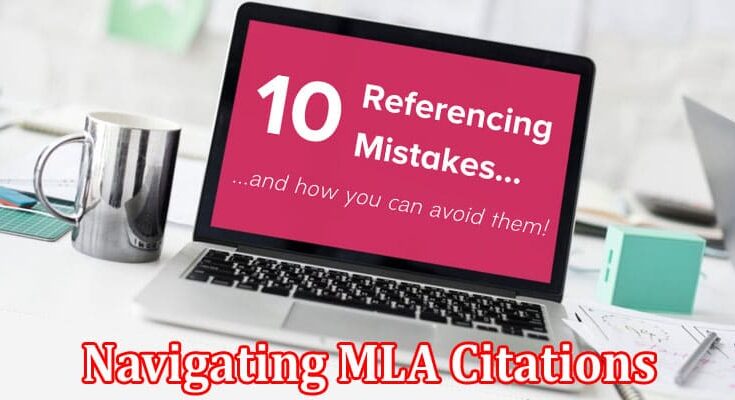Accurate and proper citations are the bedrock of scholarly writing, playing a pivotal role in upholding academic integrity, acknowledging sources, and fostering a transparent exchange of knowledge. Among the various citation styles, the Modern Language Association (MLA) style stands as a widely used and respected framework for documenting sources in humanities and liberal arts disciplines. In this article, we delve into the intricacies of MLA citations, shedding light on the nuances often overlooked by writers. Our aim is to provide a comprehensive guide to navigating the MLA citation landscape, specifically focusing on the prevalent mistakes that writers frequently encounter.
Citations not only lend credibility to your work but also exhibit respect for the intellectual contributions of others. They allow readers to trace the origins of ideas, verify facts, and explore further avenues of research. Accurate citations offer a shield against plagiarism, ensuring that your work remains ethically sound and rooted in a foundation of trust. Whether you’re a student, researcher, or writer, mastering proper citation techniques is essential for contributing responsibly to the academic community. Hiring a paper writer can be a convenient option for busy students seeking assistance with their assignments, but it’s essential to ensure that the services chosen prioritize originality and quality.
The MLA citation style, established by the Modern Language Association, provides a consistent and structured approach to citing various types of sources, including books, articles, websites, and more. It employs a straightforward parenthetical author-page format for in-text citations and mandates the inclusion of a comprehensive Works Cited page at the end of your paper. MLA style emphasizes clear attribution, uniform formatting, and clarity, allowing readers to swiftly locate and verify the sources you’ve referenced.
While the principles of MLA citation may seem straightforward, the devil often lies in the details. This article serves as a guide to help writers navigate the potential pitfalls of MLA citations. We’ll dissect and illuminate the common mistakes that can inadvertently arise during the citation process. By dissecting these errors and offering clear solutions, we aim to empower writers with the knowledge and skills needed to craft accurate and flawless MLA citations.
MLA Citation Basics
The Modern Language Association (MLA) citation style provides a systematic method for documenting sources in academic writing. Its primary goal is to offer clear and consistent attribution while maintaining readability and ease of reference. MLA format is commonly used in humanities and liberal arts disciplines, encompassing a wide range of source types, from traditional print materials to digital resources.
Components of an MLA Citation
- Author’s Name: The author’s name is typically listed in reverse order, with the last name followed by the first name. For works with a single author, the format is: Last Name, First Name. In cases with multiple authors, the first author’s name is inverted, while subsequent authors’ names are listed in regular order.
- Title of the Source: The title of the source, whether it’s a book, article, or website, should be italicized or placed within quotation marks based on its type and length.
- Title of the Container: The title of the container is the larger work that holds the source. For instance, an article might be contained within a journal or an essay within an edited anthology. Properly identifying the container is crucial for accurate citation.
- Other Contributors: If the source involves contributions beyond the primary author, such as editors, translators, or illustrators, their roles and names should be included in the citation.
- Publication Date: The publication date indicates when the source was released or published. It is often found on the title page, copyright page, or the website’s footer.
- Location (Page Numbers, URL, etc.): Depending on the type of source, the location can vary. For print sources, this includes page numbers. For online sources, it may involve URLs or other identifiers, such as paragraph or line numbers.
In-text Citations and Parenthetical References
In-text citations are used to indicate the source of information within the body of your paper. The MLA parenthetical reference format usually consists of the author’s last name and the page number(s) where the information can be found in the source. If the author’s name is already mentioned in the sentence, only the page number(s) need to be included in the parentheses.
The Works Cited page is a comprehensive list of all the sources you’ve referenced in your paper. Entries are arranged alphabetically by the authors’ last names or by the title if there is no author. Each entry follows a specific format, including author name, title of the source, title of the container, other contributors, publication date, and location details. While there are various essay writing services available to assist students in their academic journey, entries should have a hanging indent, where the first line is flush left and subsequent lines are indented. The Works Cited page provides readers with the information they need to locate the sources you’ve used in your research.
Remember, adhering to the guidelines outlined by MLA format ensures that your citations are clear, accurate, and consistent, which in turn enhances the overall quality of your work.
Common Mistakes in MLA Citations
- Multiple Authors: Mistakes often occur when dealing with sources authored by multiple individuals. It’s crucial to list all authors’ names, either in the order they appear on the source or following the guidelines provided by MLA style.
- Corporate Authors: When a source is produced by an organization or corporation, ensure that the proper entity is credited as the author. Avoid using abbreviations or acronyms that might lead to confusion.
- Italics and Quotation Marks: Knowing when to italicize and when to use quotation marks can be confusing. In general, longer works like books, journals, and websites are italicized, while shorter works like articles, essays, and poems are placed in quotation marks.
- Capitalization Errors: Proper capitalization is essential in MLA citations. Major words in titles and subtitles should be capitalized, while conjunctions, articles, and prepositions should follow standard capitalization rules unless they are the first or last words.
- Differentiating Between Source and Container Titles: The distinction between a source and its container can be tricky. The source title refers to the individual work you are citing, while the container title pertains to the larger collection in which the source is found. Clarifying this difference is vital for accurate citations.
- Formatting Titles for Different Types of Sources: Different types of sources require specific formatting. For instance, book titles are italicized, while article titles are placed in quotation marks. Understanding these variations helps prevent errors.
- Publication Dates: Accurate publication dates are essential for proper citations. Ensure you use the correct date, which might include the original publication date for reprints or the online publication date for web sources.
- Page Numbers, Paragraphs, and Line Numbers: Precise location information is vital for in-text citations. For print sources, use page numbers. For digital sources, use paragraph or line numbers, especially for content that lacks traditional pagination.
- Editors, Translators, and Other Contributors: Give credit to individuals who contribute to a source beyond the primary author, such as editors or translators. Including their names and roles in your citations is important for acknowledging their contributions.
- URL Structure: For web sources, accurately format URLs and ensure they are functional. Include the full URL, and if it’s too lengthy, use a shortened version while ensuring it directs readers to the correct page.
- Date of Access: Include the date you accessed the online source, as online content can change. This information is crucial for maintaining the integrity of your sources and providing readers with accurate references.
- Properly Attributing Ideas and Information: Citing sources isn’t just about quoting directly; it’s also about acknowledging the origin of ideas and information that you’ve paraphrased or summarized. Failing to attribute such content could lead to unintentional plagiarism.
Understanding and avoiding these common mistakes is fundamental to producing accurate and ethically sound MLA citations, ensuring that your work is both academically rigorous and respectful of intellectual property. By addressing these issues head-on, you’ll enhance the credibility and reliability of your research.
Tips for Accurate MLA Citations
Citation generators can be incredibly useful tools for creating MLA citations. However, it’s crucial to use reputable and reliable generators to ensure accuracy. Always review the generated citations to verify that all components are correctly formatted and that no errors have been introduced.
Before citing a source, meticulously review it to ensure that all necessary details—such as author names, publication dates, and page numbers—are accurate. Mistakes in these details can lead to incorrect citations and confusion for your readers.
The official MLA Handbook is your ultimate guide to mastering MLA citation style. This resource provides detailed explanations, examples, and clarifications for all aspects of MLA citations. Whenever in doubt, consult the handbook to ensure you’re following the most up-to-date guidelines.
If you encounter challenging sources or confusing citation scenarios, don’t hesitate to reach out to your instructors or librarians for assistance. They are experienced in navigating citation complexities and can provide valuable guidance.
Consistency is key in MLA citations. Maintain uniformity in your formatting, capitalization, and punctuation across all citations in your paper. This consistency not only enhances the visual appeal of your work but also makes it easier for readers to locate and understand your references.
Mastering MLA citations is a skill that requires attention to detail, practice, and a commitment to accuracy. By understanding the fundamental components of MLA format, recognizing and avoiding common mistakes, and implementing the provided tips, you can confidently navigate the world of MLA citations.
Accurate citations not only elevate the quality of your academic writing but also contribute to the integrity and credibility of the scholarly community as a whole. As you continue to refine your citation skills, remember that precision in citation reflects a commitment to scholarly excellence and responsible research practices.

Caroline is a dedicated writer with a passion for keeping readers informed. Specializing in providing the latest news updates and unbiased reviews, she strives to deliver accurate and insightful content. With a keen eye for detail and a commitment to journalistic integrity, Caroline ensures that her readers are always well-informed. Stay tuned for her latest articles to stay up-to-date on current events and trends.




